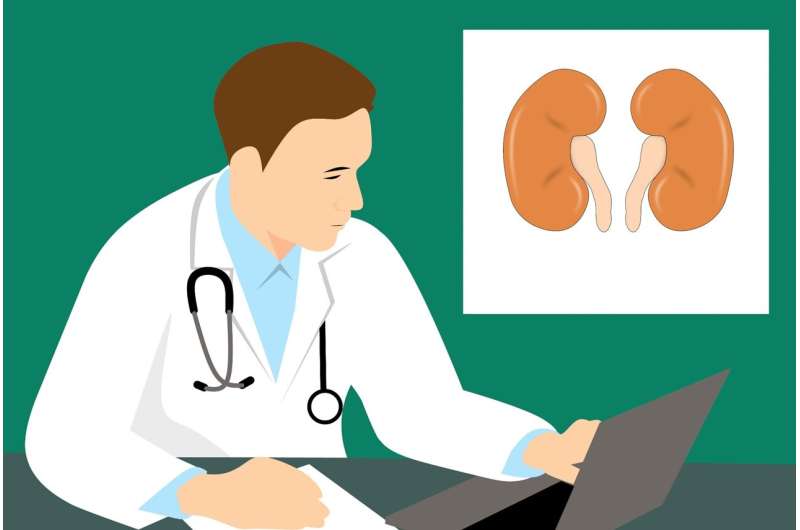This article has been reviewed according to Science X's editorial process and policies. Editors have highlighted the following attributes while ensuring the content's credibility:
fact-checked
peer-reviewed publication
trusted source
proofread
Radiology test can be used to diagnose immune checkpoint inhibitor-associated acute kidney injury

Immune checkpoint inhibitors (ICIs) are a class of immunotherapy that have revolutionized the treatment of cancer. However, they can cause a wide variety of autoimmune toxicities, including immune checkpoint inhibitor-associated acute kidney injury (ICI-AKI).
Differentiating ICI-AKI from acute kidney injury (AKI) due to alternative causes, which are common in cancer patients, is challenging without a kidney biopsy due to the risk of bleeding for some patients.
In a study published in Journal of Clinical Investigation, researchers examined whether F18-FDG PET-CTs, a type of nuclear imaging study, could be used to distinguish patients with ICI-AKI from those with AKI from alternative causes.
They found that patients with ICI-AKI had much higher levels of radioactively-labeled glucose in the kidneys, indicating kidney inflammation, compared to patients with AKI from non-ICI causes. These findings indicate that this type of radiographic scan could be a non-invasive alternative to kidney biopsy for diagnosing ICI-AKI.
Previous research has demonstrated that the most common finding from kidney biopsies in patients with ICI-AKI is acute interstitial nephritis, or inflammation in the kidney as a result of activated T-cells. To diagnose this condition in current practice, patients must undergo a kidney biopsy.
However, patients may have contraindications (e.g., they may have only one kidney or they may be receiving treatment with blood thinners), preventing them from proceeding safely with a kidney biopsy. Thus, non-invasive markers are greatly needed to diagnose ICI-AKI.
Case reports and smaller studies had explored the utility of F18-FDG PET-CT scans as a non-invasive option for diagnosing ICI-AKI, but those studies had significant limitations, including small sample size, lack of clear inclusion and exclusion criteria, and lack of a control group.
In this study, the team sought to address these limitations and investigate the utility of F18-FDG PET-CTs as a way to non-invasively diagnose ICI-AKI.
Using data from a previous multi-center study of patients with ICI-AKI, the study focused on those who had a F18-FDG PET-CT scan around the time of ICI-AKI diagnosis.
The study included two control groups: patients with AKI from non-ICI etiologies and patients treated with ICIs who did not have AKI at the time of a follow-up F18-FDG PET-CT. For all three groups, patients were included if they had F18-FDG PET-CTs scans at baseline and within 14 days of AKI onset (or, for the second control group, a follow-up scan between 90–365 days following ICI initiation).
Nuclear radiologists reviewed the F18-FDG PET-CTs at baseline and follow-up and recorded the average radiotracer standardized uptake value (SUV) in the renal cortices. The SUV quantifies the amount of radioactively-labeled glucose in the kidneys, serving as a marker of the amount of inflammation and metabolic activity occurring in the kidneys.
The team then calculated the average percent change in SUV from baseline to follow-up for each patient. The SUV mean increased by a median of 57.4% from baseline to follow-up among patients with ICI-AKI, whereas it only increased by 8.5% among patients with AKI from non-ICI causes and was unchanged in patients receiving ICIs without AKI.
The findings suggest that F18-FDG PET-CTs may be a useful test for diagnosing ICI-AKI.
The team's hope is to offer patients who can't undergo a kidney biopsy safely a non-invasive testing option, such as with F18-FDG PET-CTs scans, to differentiate the cause of AKI as being ICI-related vs. non-ICI-related. This has important implications for patients, because those with ICI-AKI are treated promptly with steroids, and their ICI therapy is typically held until their AKI has recovered or at least stabilized.
The next step is to validate these findings in a larger prospective study where the investigators recruit patients who have AKI while on ICI treatment to see if F18-FDG PET-CTs can definitively differentiate ICI-AKI from AKI from non-ICI causes.
More information: F18-FDG PET imaging as a diagnostic tool for immune checkpoint inhibitor-associated acute kidney injury, Journal of Clinical Investigation (2024). DOI: 10.1172/JCI182275. www.jci.org/articles/view/182275

















